Organized tours are a mixed blessing for me. On one hand, you don't have to think and organize and plan how you're going to get around to certain places. You don't have to worry about when things will be open or wait in line for tickets or how much time to alot to this and that. They've done all that for you. On the other hand -- they've done all that for you, and the result is often a very canned experience where the tour company points you at where to shop, what to look at, and tries to squeeze as much "doing" in as little time as possible.
Eg: this tour. The Bavarian countryside is gorgeous, with rolling hills, smoky mountains and quaint farmhouses, and we certainly got to see a lot of it as the drive to the first stop on the tour was nearly an hour and a half from Munich.
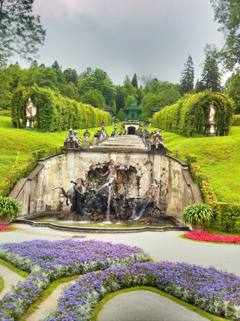 The destination of the first tour stop was the second castle he lived in, and the only one to be completed in his lifetime -- Linderhof. Linderhof is the smallest of "Mad King" Ludwig's creations and is modeled extensively after Louis the XIV's Palace at Versailles. The castle is a homage to Louis the XIV's absolute monarchy and the divine right of kings and is a prime example of decadent Roccoco style. The most fascinating part of the tour for me was seeing the king's small dining table, which could be raised and lowered into his private dining hall so he wouldn't have to interact with his servants or be disturbed. Ludwig was a bit of a loner.
The destination of the first tour stop was the second castle he lived in, and the only one to be completed in his lifetime -- Linderhof. Linderhof is the smallest of "Mad King" Ludwig's creations and is modeled extensively after Louis the XIV's Palace at Versailles. The castle is a homage to Louis the XIV's absolute monarchy and the divine right of kings and is a prime example of decadent Roccoco style. The most fascinating part of the tour for me was seeing the king's small dining table, which could be raised and lowered into his private dining hall so he wouldn't have to interact with his servants or be disturbed. Ludwig was a bit of a loner. The second stop was the cheery little tourist-trap village of Oberammergau, known for its every-ten-year passion play (that lasts 7 hours) and its traditional woodwork. We skipped both and chose to walk around the town for the 40 minutes the tour had designated for shopping at the suggested souvenir shops.
The final stop on the tour was Neuschwanstein, Ludwig the Second's most famous castle. It is known for, among many things, being the inspiration for Disney's castle at the Magic Kingdom.
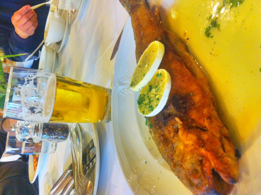 But before that, lunch. We went to the tour's suggested restaurant at the base of the mountain where Neuschwanstein is located. My father had a small bowl of Gulash soup and I decided to be adventurous and try the whole fried river trout. While some people may find the idea of eating a fish with its face and fins still attached, such things have never bothered me. I think I might have weirded out the couple that was sharing a table with us, but to heck with them. It was delicious -- obviously very fresh, with a nice rivery taste and delicate, perfectly edible pinbones. Good, good, good.
But before that, lunch. We went to the tour's suggested restaurant at the base of the mountain where Neuschwanstein is located. My father had a small bowl of Gulash soup and I decided to be adventurous and try the whole fried river trout. While some people may find the idea of eating a fish with its face and fins still attached, such things have never bothered me. I think I might have weirded out the couple that was sharing a table with us, but to heck with them. It was delicious -- obviously very fresh, with a nice rivery taste and delicate, perfectly edible pinbones. Good, good, good. The tour guide on the bus had informed us that it was an "easy 40 minute walk" up the mountain to the castle entrance, and that taking a bus would probably mean waiting almost as long, since the bus schedule going up to Neuschwanstein is oddly intermittent. So we decided to brave it. The mountain scenery was very nice, but boy was that a brutal climb. It took only 30 minutes, but I was worried that I was going to have to put dad down by the side of the road at one point, poor fella. 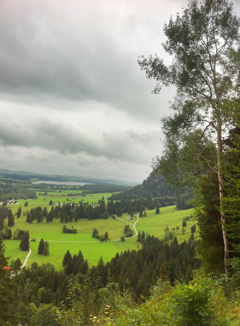 We did make it up, with plenty of time to spare for exterior photographs and landscape shots before the tour. Half the exterior of the castle is under extensive refurbishment and was covered in scaffolding, but I still managed to get some ok shots from certain angles.
We did make it up, with plenty of time to spare for exterior photographs and landscape shots before the tour. Half the exterior of the castle is under extensive refurbishment and was covered in scaffolding, but I still managed to get some ok shots from certain angles.
 We did make it up, with plenty of time to spare for exterior photographs and landscape shots before the tour. Half the exterior of the castle is under extensive refurbishment and was covered in scaffolding, but I still managed to get some ok shots from certain angles.
We did make it up, with plenty of time to spare for exterior photographs and landscape shots before the tour. Half the exterior of the castle is under extensive refurbishment and was covered in scaffolding, but I still managed to get some ok shots from certain angles. The tour of the interior of the castle begins with a torturous walk up one of the parapets, into the entrance hall and servants quarters. Then a small walk, and another brutal spiral climb into the king's throne room and personal chambers. All of the rooms in Neuschwanstein are themed after German myths that the composer Wagner turned into operas -- Sigfried, Tristan and Isolde and Parsifal are the prime targets. There may have been more tribute rooms planned, but the castle was never finished. Ludwig died mysteriously as a young man of 40 during its construction and all work on the castle immediately ceased.
Within Neuschwanberg are several noteworthy constructions (and needless to say, the exterior is noteworthy as well.) The first is Ludwig's "throne room" which I put in quotes because a throne was never installed or constructed for it. It does house a cool chandalier, an impressive mosaic floor, and a wall mural of St. George slaying a dragon -- and who doesn't love that, right?
The next rooms, his personal living quarters, are painted with murals from his favorite Wagner opera, Tristan and Isolde. Woodcarvers took four years to complete the work in this room, specifically the canopy of his four-post bed, which is an amalgam of the spires of great cathedrals throughout Europe.
Connecting his living quarters to his study is a small room designed to look like the interior walls of a cavern. These were actually lit up with electric lights run on batteries, even during Ludwig's time here. It was made to look like the Grotto of Venus, which is a part of Wagner's opera Tännhauser.
The last room of note was the Singer's Hall, painted based on scenes from Wagner's Percifal as he quested for the holy grail. Ludwig never actually heard a single performance in the Singer's hall, as he died after living just 160 days in the castle.
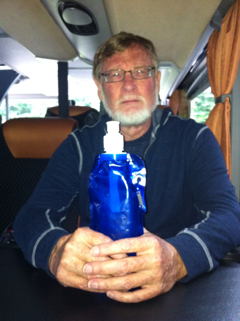 After the tour we made the walk back down the mountain with our legs promising great horrors inflicted upon us come the morrow's sunrise. But made it we did, and returned to the bus for a 2 hour ride back to Munich in the light rain that followed us.
After the tour we made the walk back down the mountain with our legs promising great horrors inflicted upon us come the morrow's sunrise. But made it we did, and returned to the bus for a 2 hour ride back to Munich in the light rain that followed us. When we got to Munich, I had developed a powerful hunger. Oh yes. Time for one of Munich's great traditions -- the beirhall. We went to a place called Augustiner-Keller just outside of the Haupftbahnhof, and sat down at a long table with a very drunk, very rowdy group of Brittons, who provided us with plenty of entertainment as we ate our Bavarian speciality foods and drank our Bavarian beers.
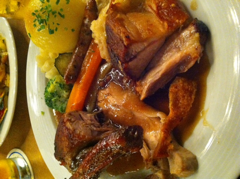 Dad had a...well it was a plate of sausages, really. I don't how else to describe it. I had a sampler plate of Bavarian classics -- suckling pig, pork knuckle, roasted duck...there might have been some other meat in there. I really don't know. Overall it was passable food -- not the best we've had, but not bad, and the bierhall experience made it worthwhile anyway.
Dad had a...well it was a plate of sausages, really. I don't how else to describe it. I had a sampler plate of Bavarian classics -- suckling pig, pork knuckle, roasted duck...there might have been some other meat in there. I really don't know. Overall it was passable food -- not the best we've had, but not bad, and the bierhall experience made it worthwhile anyway. And thus I successful kept my father out and and about past sundown for one day.
Tomorrow we've got another palace to visit in Munich and some museums to hit up. I'm still trying to get my hands on an offal dish called Beuscherl, so I'l try to find a place that serves it tomorrow.

No comments:
Post a Comment